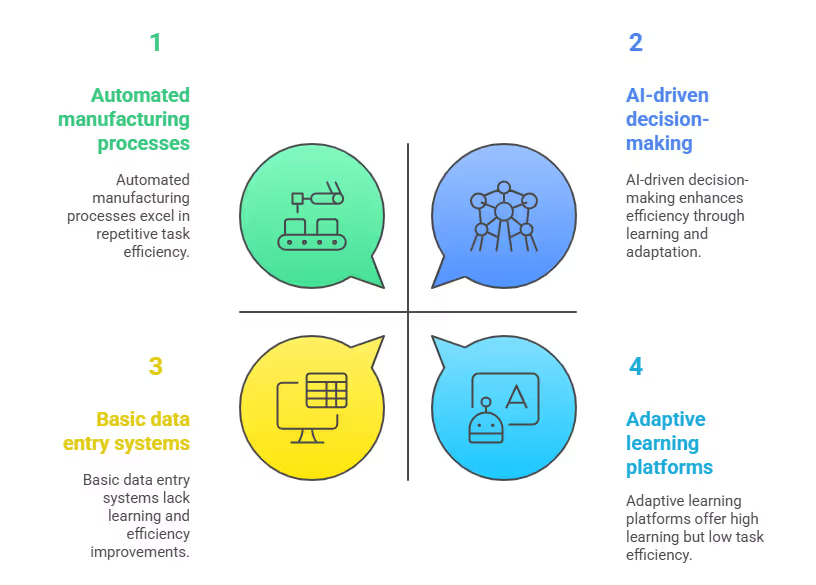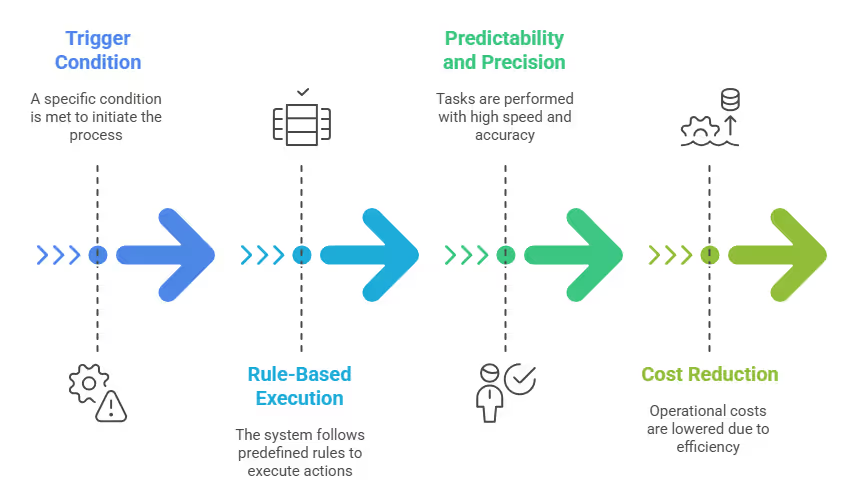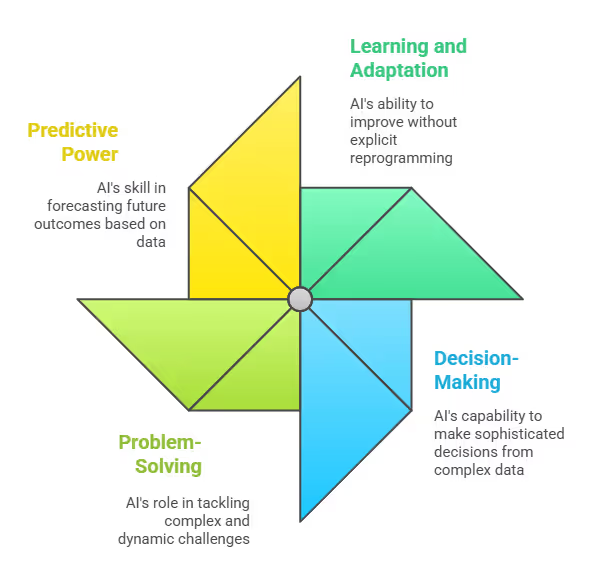AI vs Automation: Simple Guide for Beginners

AI vs. Automation: A Strategic Blueprint for U.S. Business Efficiency and Growth
As an AI agent development company, with over a decade of partnership with U.S. businesses, we consistently observe a critical strategic misstep: the interchangeable use of "AI" and "automation." Decision-makers in U.S. manufacturing hubs, financial centers, and tech valleys frequently conflate these terms, leading to misdirected investments and missed opportunities. Understanding the core difference between AI and automation is not just an academic exercise; it is a fundamental strategic imperative for achieving tangible business outcomes across the United States.
Our team has completed over 150 successful projects, delivering robust Product Engineering Services, intuitive Web App Development solutions, and cutting-edge Generative AI Chatbots tailored for complex business needs. We've consistently found that while automation excels at streamlining repetitive tasks, AI goes further by enabling learning, adaptation, and intelligent decision-making at scale. This comprehensive guide will dissect the difference between automation and AI, highlight their unique strengths, and provide a strategic blueprint for U.S. companies to leverage both for unparalleled efficiency and innovation.
Automation executes predefined rules for efficiency, while AI learns, adapts, and makes intelligent decisions, offering U.S. businesses distinct yet complementary pathways to operational excellence.
Table of Contents
- The Foundation: Unpacking Automation for U.S. Industries
- The Evolution: Diving into Artificial Intelligence for U.S. Businesses
- The Critical Difference Between AI and Automation
- Solving U.S. Business Problems: The Synergy of AI and Automation
- The Future for U.S. Businesses: Trends and Strategies
- People Also Ask

The Foundation: Unpacking Automation for U.S. Industries
Automation fundamentally involves programming machines or systems to perform tasks automatically, based on a fixed set of rules or workflows. It is about consistent, repeatable execution, reducing the need for human intervention in predictable processes. For a U.S. automotive manufacturer like Ford, this means robotic arms on an assembly line. For a financial services firm in Boston such as Fidelity Investments, it involves automated data reconciliation or transaction processing.
What is Automation? Beyond Repetitive Tasks
Automation has formed a bedrock of industrial efficiency in the U.S. for decades. It sets up a sequence of actions that, once triggered, execute without manual input.
These range from simple email auto-responses to complex, multi-stage production lines.

- Rule-Based Execution: Automation operates strictly on "if-then" logic. If a specific condition is met, a predefined action occurs. There is no learning or deviation from the programmed path. For example, U.S. logistics giants like FedEx use automated conveyor belts to sort millions of packages daily based on pre-programmed destination codes. Visit the FedEx website for more on their operations.
- Predictability and Precision: Automated systems perform tasks with remarkable speed and accuracy, minimizing human error and ensuring consistent output. According to a 2024 report by Mordor Intelligence, the U.S. factory automation and industrial controls market reached USD 49.22 billion in 2025, driven by the need for enhanced precision and efficiency. You can find more details in the Mordor Intelligence report.
- Cost Reduction: By reducing manual labor and associated errors, automation directly contributes to lower operational costs. A significant 60% of companies had implemented some form of automation by 2024, with expectations for this number to keep climbing, as noted by Vena Solutions, primarily due to the tangible Return on Investment (ROI).
Real-World Automation Examples in U.S. Sectors
Across various U.S. industries, automation is deeply embedded:
- Manufacturing: Industrial robotics dominates this sector. In Q1 2025 alone, North American companies ordered 9,064 new industrial robots, valued at $580.7 million, highlighting the ongoing investment in automating tasks like welding, painting, and assembly, particularly in the automotive industry, which accounted for 30% of the U.S. industrial automation market in 2024. Companies like General Motors and Ford have utilized extensive automation for decades to achieve high-volume production. Visit the Ford Motor Company website and General Motors website-
- Finance: Automated Clearing House (ACH) networks process billions of electronic payments annually. Robotic Process Automation (RPA) tools like UiPath are used by major U.S. banks, including JPMorgan Chase, to automate tasks such as fraud detection (91% of U.S. banks use AI for this, per Artsmart.ai's 2025 data), account reconciliation, and loan origination, saving finance teams an average of 500+ hours annually on payment automation alone. Learn more about JPMorgan Chase and UiPath.
- Retail: Amazon's fulfillment centers across the U.S., such as those in Jacksonville, Florida, employ thousands of Kiva robots (now Amazon Robotics) to manage inventory and fulfill orders with remarkable speed. Self-checkout kiosks are also a ubiquitous sight in retail chains like Walmart and Kroger. Explore Amazon's operations.
- Healthcare: Automated pharmacy dispensing systems at hospitals like the Mayo Clinic in Rochester, Minnesota, improve medication safety and reduce manual errors. Automated scheduling systems manage millions of patient appointments nationwide. Visit the Mayo Clinic website.
The fundamental limitation of automation is its inability to learn, adapt to unforeseen circumstances, or make decisions outside its pre-programmed rules. This is precisely where Artificial Intelligence comes into play.
The Evolution: Diving into Artificial Intelligence for U.S. Businesses
Artificial Intelligence (AI) simulates human-like intelligence, enabling systems to learn from data, identify complex patterns, and make informed decisions or predictions. Unlike static automation, AI systems are dynamic and can evolve, improving their performance over time as they process more information.
This is the core difference between automation and artificial intelligence.
What is AI? Intelligence Beyond Programmed Rules
AI is a vast field encompassing machine learning, deep learning, natural language processing (NLP), and computer vision.
It empowers machines to "think" and "reason" in ways once exclusive to humans.

- Learning and Adaptation: AI algorithms train on extensive datasets. They learn underlying patterns and derive insights, allowing them to adapt to new situations and improve their accuracy without explicit reprogramming for every new scenario. For instance, Netflix saves an estimated $1 billion annually by adopting machine learning technology to provide personalized recommendations for its over 70 million U.S. subscribers.
- Decision-Making: AI analyzes vast amounts of complex, often unstructured, data to make sophisticated decisions or recommendations. This is vital for tasks requiring judgment, such as identifying anomalies or predicting market trends.
- Problem-Solving: AI tackles problems too complex or dynamic for traditional automation, like optimizing global supply chains in real-time or discovering new drug compounds.
- Predictive Power: By analyzing historical data, AI can predict future outcomes. For U.S. e-commerce businesses, this means forecasting demand for products like Nike sneakers or Apple devices with greater accuracy, optimizing inventory and reducing stockouts.
Key AI Sub-fields and Their Impact on U.S. Sectors
AI's diverse applications are reshaping industries across the U.S.:
- Machine Learning (ML): Used extensively for predictive analytics and fraud detection. Financial firms in the U.S., including American Express, leverage ML to analyze transaction patterns and flag suspicious activities, helping to prevent billions of dollars in losses annually.
- Natural Language Processing (NLP): Powers conversational AI, sentiment analysis, and intelligent document processing. U.S. customer service centers increasingly deploy NLP-driven virtual assistants. For example, by 2025, 95% of consumer interactions are anticipated to be assisted by AI, according to Demand Sage.
- Generative AI: This rapidly growing field creates new content, from text and images to code. U.S. marketing agencies in cities like Los Angeles use generative AI to create personalized ad copy and campaign ideas at scale. Our Generative AI Chatbots leverage this technology to provide more nuanced and helpful customer interactions.
- Computer Vision: Enables visual recognition tasks, like facial recognition, quality control in manufacturing, and analyzing medical images. Healthcare organizations like Geisinger in Pennsylvania use computer vision to analyze medical scans, aiding in earlier disease detection.
As of 2025, nearly 90% of businesses adopt AI solutions to remain competitive, with 73% of U.S. companies already including AI in some segments of their workflow, demonstrating AI's growing footprint in the American economy.
The Critical Difference Between AI and Automation
While both AI and automation aim for efficiency, their core methodologies and capabilities are distinct.
Grasping this difference between automation and AI is key to their effective deployment.
This comparison underscores that automation vs ai is not a matter of choosing one over the other, but understanding their complementary roles. Automation handles the "how," while AI addresses the "what" and "why."
Automation vs. Artificial Intelligence: A Practical Scenario
Consider a U.S. supply chain management company, like UPS, dealing with millions of packages daily.
- Automation in action: Their facilities use automated sorting systems that scan package barcodes and direct them to the correct conveyor belts based on zip codes and weight limits. This system efficiently handles high volumes of known, structured data, moving parcels from point A to point B with immense speed and accuracy. If a barcode is unreadable or a package is oversized, the automated system might flag it for manual intervention, as it cannot "think" beyond its programmed rules.
- AI in action: An AI-powered route optimization system could analyze real-time traffic data, weather conditions, delivery truck capacity, driver availability, and even historical delivery times for specific routes. If a major accident closes a highway in California, the AI could instantly re-route thousands of packages across the affected region, minimizing delays and fuel consumption by recalculating optimal paths. It could also predict maintenance needs for trucks before they break down, sending automated alerts to the service department.
This distinction highlights how what is the difference between ai and automation translates into tangible operational impact, particularly for large-scale U.S. logistics. Automation keeps the gears turning, while AI intelligently adjusts the machine to unforeseen conditions and optimizes for overall performance.
Solving U.S. Business Problems: The Synergy of AI and Automation
The most profound transformations for U.S. businesses, from agile startups in Austin, Texas, to established manufacturing giants in Ohio, arise from strategically integrating AI and automation.
This is where the nuanced ai and automation difference becomes a powerful competitive advantage.
Automation as the Enabler for AI
Automation sets the stage for effective AI deployment. Before AI can make intelligent decisions, it requires clean, consistent data and streamlined processes.
Automation facilitates this by:
- Streamlining Data Pipelines: Automated systems reliably collect, cleanse, and structure vast amounts of data, creating the high-quality datasets essential for training robust AI models. For example, an automated sales force automation (SFA) system for a U.S. pharmaceutical company can feed real-time sales data directly into an AI for drug efficacy analysis or personalized marketing campaign generation.
- Executing AI Outputs: Once an AI makes a prediction or decision, automation can trigger the necessary actions. An AI might identify a high-risk insurance claim, but an automated workflow then flags it for review by a human adjuster at a firm like State Farm.
- Freeing Human Capital: By automating routine tasks, U.S. organizations free their workforce from mundane work, allowing employees to focus on more strategic initiatives like data analysis, creative problem-solving, or client relationship management – areas where human intelligence is irreplaceable. This also helps mitigate the projected AI-driven job displacement, which could affect 16% of American jobs by 2025 (Demand Sage), by creating new, higher-value roles.
AI Elevating Automation
Conversely, AI enhances automation, transforming it from rigid, rule-based execution to intelligent, adaptive processes:
- Intelligent Process Automation (IPA): This is where AI and automation converge. RPA bots augmented with AI capabilities (like NLP or computer vision) can process unstructured data, interpret human intent, and adapt to changing inputs. For instance, a U.S. legal firm using IPA could automatically categorize and extract key information from thousands of legal documents, even if formats vary widely, using AI to "read" and understand content.
- Proactive Exception Handling: AI learns to identify and handle exceptions that would halt a traditional automated process, significantly reducing manual intervention and increasing the resilience of automated workflows. A banking automation system, for instance, might use AI to detect unusual transaction patterns that deviate from established rules, flagging them for investigation rather than just failing.
- Continuous Optimization: AI constantly analyzes the performance of automated processes, pinpointing bottlenecks and suggesting improvements, or even autonomously reconfiguring workflows for optimal efficiency. American Airlines, for example, uses AI to continuously optimize flight schedules and crew assignments, adapting to real-time weather and operational changes.
- Predictive Maintenance: In manufacturing, AI analyzes sensor data from machinery to predict when equipment (e.g., in a Boeing factory in Washington) is likely to fail, triggering automated maintenance schedules before a costly breakdown occurs. This can reduce unplanned downtime by as much as 20-30%, a critical factor for manufacturers aiming for lean operations.
This synergistic relationship addresses the inherent limitations of each technology when used in isolation. Automation provides the predictable efficiency for known processes, while AI brings the intelligence, adaptability, and foresight to handle complexity and drive continuous improvement.
The Future for U.S. Businesses: Trends and Strategies
The trajectory of AI and automation in the U.S. is one of increasing integration and sophistication.
Businesses must embrace these trends to maintain a competitive edge.
Emerging Trends for U.S. Adoption
- Hyperautomation: This isn't just about automating tasks, but automating the automation process itself. For U.S. enterprises, this means leveraging AI and machine learning to identify and automate more business processes across the organization, including tasks that currently require human judgment. Over 80% of organizations accelerated Business Process Automation (BPA) adoption due to the pandemic, indicating a rapid shift towards hyperautomation.
- Democratization of AI: Tools and platforms like low-code/no-code interfaces are making AI development more accessible to a wider range of U.S. businesses, not just those with large data science teams. This empowers domain experts to build AI solutions tailored to their specific needs.
- Ethical AI and Trust Frameworks: As AI becomes more pervasive, U.S. consumers and regulators demand greater transparency, fairness, and accountability. Businesses will increasingly focus on developing and deploying AI systems that adhere to ethical guidelines, building public trust. The National Institute of Standards and Technology (NIST) AI Risk Management Framework is a key reference for U.S. companies in this regard.
- AI-Driven Decision Intelligence: Moving beyond simply providing data, AI will increasingly offer prescriptive insights and recommendations, guiding strategic decisions. For U.S. agricultural companies in the Midwest, this could mean AI advising on optimal planting times, crop rotation, and resource allocation based on soil data and weather patterns.
- Human-AI Collaboration (Augmented Intelligence): The focus will shift from AI replacing jobs to AI augmenting human capabilities. By 2025, AI is expected to replace 85 million jobs globally but create around 97 million new roles (World Economic Forum), highlighting a net gain and the creation of new opportunities for skilled human-AI collaboration. Access the World Economic Forum for more insights.
We specialize in providing comprehensive Product Engineering Services, designing scalable Web App Development solutions, and deploying sophisticated Generative AI Chatbots that address your unique business challenges. We believe in clear, honest, and results-driven partnerships that deliver measurable value.
Let's collaborate to build an intelligent future for your U.S. business, where AI and automation work in perfect synergy to achieve your strategic objectives.

